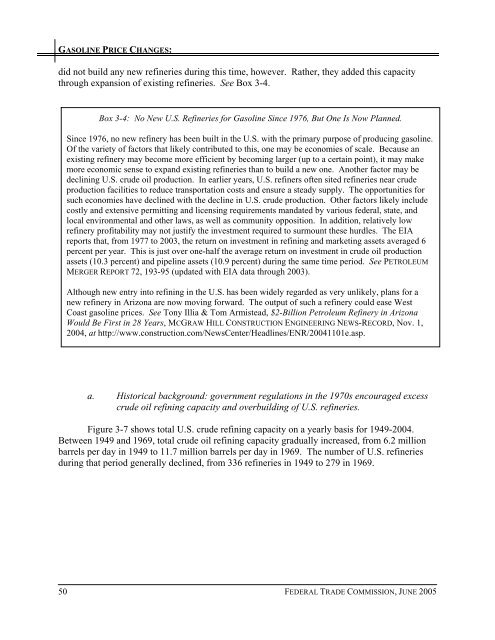Gasoline Price Changes - Federal Trade Commission
Gasoline Price Changes - Federal Trade Commission
Gasoline Price Changes - Federal Trade Commission
You also want an ePaper? Increase the reach of your titles
YUMPU automatically turns print PDFs into web optimized ePapers that Google loves.
GASOLINE PRICE CHANGES:<br />
did not build any new refineries during this time, however. Rather, they added this capacity<br />
through expansion of existing refineries. See Box 3-4.<br />
Box 3-4: No New U.S. Refineries for <strong>Gasoline</strong> Since 1976, But One Is Now Planned.<br />
Since 1976, no new refinery has been built in the U.S. with the primary purpose of producing gasoline.<br />
Of the variety of factors that likely contributed to this, one may be economies of scale. Because an<br />
existing refinery may become more efficient by becoming larger (up to a certain point), it may make<br />
more economic sense to expand existing refineries than to build a new one. Another factor may be<br />
declining U.S. crude oil production. In earlier years, U.S. refiners often sited refineries near crude<br />
production facilities to reduce transportation costs and ensure a steady supply. The opportunities for<br />
such economies have declined with the decline in U.S. crude production. Other factors likely include<br />
costly and extensive permitting and licensing requirements mandated by various federal, state, and<br />
local environmental and other laws, as well as community opposition. In addition, relatively low<br />
refinery profitability may not justify the investment required to surmount these hurdles. The EIA<br />
reports that, from 1977 to 2003, the return on investment in refining and marketing assets averaged 6<br />
percent per year. This is just over one-half the average return on investment in crude oil production<br />
assets (10.3 percent) and pipeline assets (10.9 percent) during the same time period. See PETROLEUM<br />
MERGER REPORT 72, 193-95 (updated with EIA data through 2003).<br />
Although new entry into refining in the U.S. has been widely regarded as very unlikely, plans for a<br />
new refinery in Arizona are now moving forward. The output of such a refinery could ease West<br />
Coast gasoline prices. See Tony Illia & Tom Armistead, $2-Billion Petroleum Refinery in Arizona<br />
Would Be First in 28 Years, MCGRAW HILL CONSTRUCTION ENGINEERING NEWS-RECORD, Nov. 1,<br />
2004, at http://www.construction.com/NewsCenter/Headlines/ENR/20041101e.asp.<br />
a. Historical background: government regulations in the 1970s encouraged excess<br />
crude oil refining capacity and overbuilding of U.S. refineries.<br />
Figure 3-7 shows total U.S. crude refining capacity on a yearly basis for 1949-2004.<br />
Between 1949 and 1969, total crude oil refining capacity gradually increased, from 6.2 million<br />
barrels per day in 1949 to 11.7 million barrels per day in 1969. The number of U.S. refineries<br />
during that period generally declined, from 336 refineries in 1949 to 279 in 1969.<br />
50<br />
FEDERAL TRADE COMMISSION, JUNE 2005
















